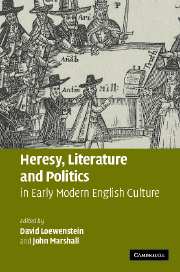Book contents
- Frontmatter
- Contents
- Acknowledgments
- Notes on contributors
- Introduction
- 1 Writing and the persecution of heretics in Henry VIII's England: The Examinations of Anne Askew
- 2 Anabaptism and anti-Anabaptism in the early English Reformation: defining Protestant heresy and orthodoxy during the reign of Edward VI
- 3 “Godlie matrons” and “loose-bodied dames”: heresy and gender in the Family of Love
- 4 Puritanism, Familism, and heresy in early Stuart England: the case of John Etherington revisited
- 5 A ticklish business: defining heresy and orthodoxy in the Puritan revolution
- 6 Thomas Edwards's Gangraena and heresiological traditions
- 7 “And if God was one of us”: Paul Best, John Biddle, and anti-Trinitarian heresy in seventeenth-century England
- 8 The road to George Hill: the heretical dynamic of Winstanley's early prose
- 9 Milton and the heretical priesthood of Christ
- 10 An Historical Narration Concerning Heresie: Thomas Hobbes, Thomas Barlow, and the Restoration debate over “heresy”
- 11 Defining and redefining heresy up to Locke's Letters Concerning Toleration
- 12 “Take heed of being too forward in imposinge on others”: orthodoxy and heresy in the Baxterian tradition
- Index
8 - The road to George Hill: the heretical dynamic of Winstanley's early prose
Published online by Cambridge University Press: 20 February 2010
- Frontmatter
- Contents
- Acknowledgments
- Notes on contributors
- Introduction
- 1 Writing and the persecution of heretics in Henry VIII's England: The Examinations of Anne Askew
- 2 Anabaptism and anti-Anabaptism in the early English Reformation: defining Protestant heresy and orthodoxy during the reign of Edward VI
- 3 “Godlie matrons” and “loose-bodied dames”: heresy and gender in the Family of Love
- 4 Puritanism, Familism, and heresy in early Stuart England: the case of John Etherington revisited
- 5 A ticklish business: defining heresy and orthodoxy in the Puritan revolution
- 6 Thomas Edwards's Gangraena and heresiological traditions
- 7 “And if God was one of us”: Paul Best, John Biddle, and anti-Trinitarian heresy in seventeenth-century England
- 8 The road to George Hill: the heretical dynamic of Winstanley's early prose
- 9 Milton and the heretical priesthood of Christ
- 10 An Historical Narration Concerning Heresie: Thomas Hobbes, Thomas Barlow, and the Restoration debate over “heresy”
- 11 Defining and redefining heresy up to Locke's Letters Concerning Toleration
- 12 “Take heed of being too forward in imposinge on others”: orthodoxy and heresy in the Baxterian tradition
- Index
Summary
Early one morning during the conference held to commemorate the 350th anniversary of the Digger experiment, I went with two friends and colleagues, with whom I have long shared an enthusiasm for the radical prose of the mid-seventeenth century, to St. George's Hill, where Gerrard Winstanley and his comrades had sought to work together the common land, thus living off the common treasury of the earth. We would have wished to visit the site anyway, though a recent event lent the expedition a surprising frisson: radical activists of uncertain political affiliation had made a covert incursion into the area and had established a self-proclaimed Digger camp on land owned by a public utility company. On that cool, bright dawn we drove to a remarkably prosperous housing complex, reputedly the home to minor expatriate royalty and popular entertainers, and I encountered for the first time in England a walled and gated estate patrolled by security guards, who barred our way.
To my mild surprise, the guards let us through – we told them we were tourists, which, in a sense, was true – and we found the camp near the crest of the hill on a patch of muddy scrubland about the size of a tennis court. Those protesters who were awake made us welcome, and, after a brief explanation of our interests in Winstanley, we looked round the camp, noting the lines of symbolically planted flowers and vegetables adjacent to the sleeping heads of the “Diggers,” admiring the elegant and rather weighty memorial stone that had been smuggled onto the site, and, somewhat incongruously perhaps, signing a visitors' book.
- Type
- Chapter
- Information
- Heresy, Literature and Politics in Early Modern English Culture , pp. 185 - 202Publisher: Cambridge University PressPrint publication year: 2006



